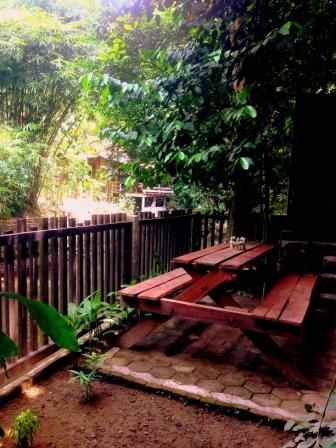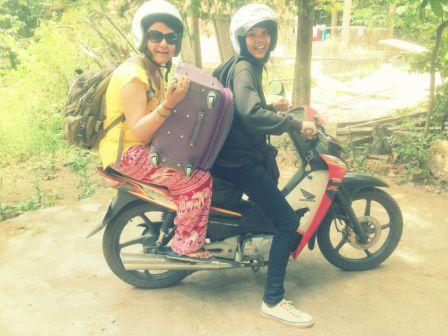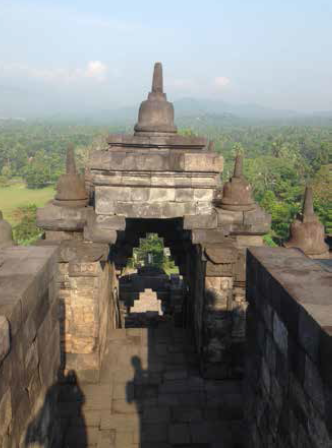 I was in Jakarta for two nights and even though meeting two Afghani men and listening to their tale of human trafficking was a riveting one and watching a Korean film with Indonesian subtitles was a moving experience, I was still eager to leave the city. I wanted cheer, more human contact, some foliage and less concrete.
I was in Jakarta for two nights and even though meeting two Afghani men and listening to their tale of human trafficking was a riveting one and watching a Korean film with Indonesian subtitles was a moving experience, I was still eager to leave the city. I wanted cheer, more human contact, some foliage and less concrete.
Jogja (officially but rarely called Yogyakarta) is a major tourist destination in Indonesia. It is the capital city of the province of Yogyakarta Special Region, which is in the southern part of the Central Java province. It was a recommendation that was being echoed by lot fellow travellers. The reasons, however, had more to do with its geography and history than its cheer and foliage. It has many wonders – an active volcano, Borobudur, Sultan’s palace, and its food – but for me the biggest draw to the place was Omah Jogek.
Omah Jogek is a jungle homestay or something like that in Jogja. An Indonesian couple, Ina and Bandizt, who have zero business sense and use all the proceeds for rescuing animals, runs it. Besides the wild, their other passions are punk rock and mucking about with friends.
I stumbled upon it after dedicating fervent hours on the internet while smoking a cigarette and sipping tea in my dimly neon-lit hotel room. Though I didn’t know what I was looking for, but knew there was a pa
ng in me that was strangely being addressed by what I was reading on Omah Jogek.
This is what Ina’s description on Air BnB read:
“It’s in the woods, with lots of wooden parts.
The name’s in Javanese, literally means Barking Home. I guess you can sense now where that will lead you. Yes, a must-love-dogs home, well, must-love-cats, too. We built the house after borrowing money from my dad (and we still owe him a lot). I hope he would always have other much more important stuffs to think about than my debt. There were no cats so we didn’t name it a Meow Home, but we keep getting discarded and abandoned kittens around. There is no option available but to look after them. We cannot eat them, of course, because we’re vegans.
Some of the cats are up for adoption”.
I’m a shameless cat lover and had been missing mine from back home. I saw the pictures of Omah Jogek and there was nowhere I wanted to be more than that place. There was one little problem though. No, money was not it as it was pretty affordable. It was the booking that had to be done online exclusively through Air BnB website. Unfortunately, my credit card is linked to my Indian cell number and as I roamed around Southeast Asia on local numbers, I couldn’t use the card for any online transactions.
The good thing was that one could correspond with Ina over Air BnB’s messaging system. However, in order to ensure that the booking is done only through the website and not directly through the owner, Air BnB restricts exchange of any emails or phone numbers. No matter how innovative you get (interspersing numbers in text or reversing the digits), they can catch you and remove all traces of it from the message – very clever of them. Both Ina and I tried them all and failed. But then I was lucky to have Ina on the other side who agreed to let me stay without paying for the room in advance.
The next morning I was there before the break of dawn after eight hours of train ride from Jakarta. I don’t remember much of the way from the station because as soon as I transferred the direction given to me by Ina to the taxi driver, I promptly dozed off on the back seat of the car. The driver woke me up as we reached the guesthouse. I looked around and suddenly I was in the middle of a jungle. It was swell.The dogs were barking and Bandizt came out, took my bags and showed me to my room. I was too bleary t o notice much but the bed reminded me of my bed in that tiny room while growing up in Dehradun. As soon as I hit the pillow I dropped off into deep, undisturbed slumber.
o notice much but the bed reminded me of my bed in that tiny room while growing up in Dehradun. As soon as I hit the pillow I dropped off into deep, undisturbed slumber.
It was the gentle purring of two cats – one curled next to my cheek and the other at my feet that finally awoke me after who knows how many hours. It was a good sleep and I was hungry. I looked around and found the room to be done in a simple, understated, elegant and utterly comfortable manner. It had open red brick walls, Oakwood, unpainted furniture, and a beautiful original canvas art of a Dutch painter who lived in the neighborhood. There was a small window with curtain that overlooked a creek below.
“This life’s journey has been so puzzling at times that my desire to find out more at those times has never been completely quenched”.
I was already feeling cheerful and there was more to come. I went outside the room and was welcomed by chirpy hellos from Georgia and Alessandro who were sitting on stone benches next to the river with their coffee, bread, and cigarettes. Perfect, just perfect! I rushed inside the kitchen to get some for myself and quickly joined them at the bench.
Georgia, a comedienne/pub singer/art student is a wild stream from Tasmania with bushy armpits that she rebels to shave. She had the brightest voice and most chatty eyes. The kind of person, you would want to bring home and have tea with and talk and talk. She had come to Indonesia with very little money on a sponsored art project in North Sumatra that fell apart. But like me, she was so taken by Omah Jogek that she decided to use all her saving to spend indefinite time at the homestay. Alessandro, the sweet, gentle, utterly attractive Italian bald was a recovering cracked-heart who lived in London. He worked for an NGO doing some completely forgettable social work and was touring Singapore on work. He had some holidays left and decided to come to Omah Jogek. Whatever the reason, I was just glad to be there at the time they were there.
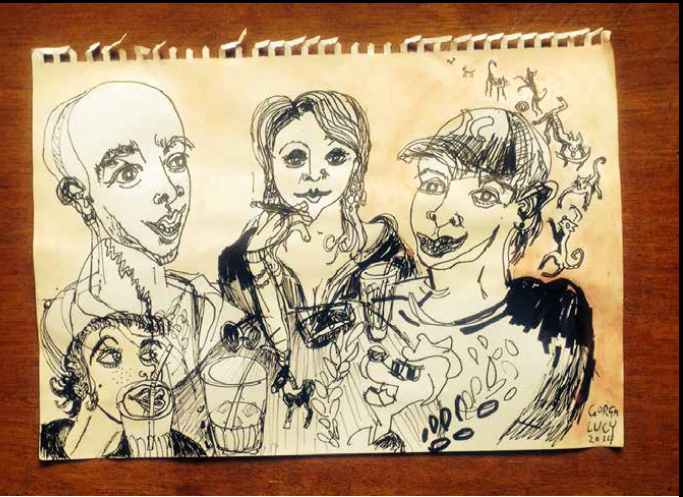
This life’s journey has been so puzzling at times that my desire to find out more at those times has never been completely quenched. But sitting next to Georgia and Alessandro, I felt a calm surrender inside of me. At the time, nothing seemed to matter. Was it the loud barks and constant miaows? Was it the rustle of leaves from the tall trees? Was it the gurgle of the flowing creek? Was it the simple organic bread and jam breakfast? Was it the active ashtray with several burnt butts? I really don’t know. I had hardly exchanged a few pleasant words with both of them, but was already in love and ready for Jogja.
Of course I saw most of the sites that had to be seen in Jogja. I went to the Sultan’s palace, climbed all the tall stairs of Borobudur. Woke up in the dark of the morning to climb a mountain and see the sunrise from behind the volcano. Drove up to the volcano on motorbikes ridden by young Javanese kids. Saw the remains of an actual house believed to be of a mythical king of Mount Merapi. The saintly man who kept the faith and continued praying while the volcano erupted and village evacuated. We made impromptu music directed by Georgia on the Gamalan (Indonesian percussion instrument) and some other broken instruments kept in the king’s desolate house. Each and every moment spent was so happy that it seemed like I was living a dream while awake.
We wandered aimlessly around the streets of Jogja, talking to strangers, eating Nasi-something and smoking some more. There were post dinner beers in the front patio of Ina’s house under starry skies. All sat around playing the guitar and singing out of tune while stealing lyrics from our iPhones. We cooked and ate together and fed ourselves something much more than food.
Here’s an ode to these strangers from that jungle in Jogja. It’s an ode to Ina, Bandizt, Elly, Fandi, Alessandro, Georgia, Leo and Bindi and Buster and Pumpkin and Hansen and Chichi.
Omah Jogek is
A home that houses animals
And it’s not the just the four-legged ones that
seek refuge for a refuge they needed to seek for long
It’s a place that calms your nerves
Agitates those molecules and
Dissolves them too
It barks and miaows
It lets you have a voice and
Muffles the city noise
It cooks and jams and stirs up a storm
Every moment unique.
Each one too special
And living it up is the norm
Time stands on a vertical plane and passes in a blink
It’s sullied and curried and stewed and soaked
It’ll make you think, un-think till the chink goes to the brink
As for me, if I begin to recount what all I miss of Omah Jogek
The days will run short and ink will run dry and I will still not be able to put a lock
On the stock
Of the sweetest barrel
I have some memories in pictures but the best ones are in my head
And I have a feeling they’ll keep churning out through the said and unsaid.
Getting around Jogja
Barring a singular slim attempt at learning how to ride a bicycle, I saw most of Jogja as a pillion rider on motorbikes behind Leo, Alessandro or Georgia. I also used the cycle rickshaw or becak (pronounced beh-chak) or simply walked. Hiring a becak is ridiculously cheap and you don’t even need to bargain. I was there between mid to end March and it was too, too sunny. I returned with an almost burnt skin and an intense tan. So smother yourself with a good dose of sunscreen.
Jogja lies in one of the most seismically active parts of Java and has been repeatedly struck by earthquakes and volcano eruptions. The worst in recent times was the earthquake in 2006, which killed over 6,000 people and flattened over 300,000 houses. In October 2010, the nearby volcano of Mount Merapi erupted, spewing lava over nearby villages and killing 353 people. Going by the past record, it’ll be another 2-3 years until the next small eruption and 10-15 years until the next big one. So pay a visit while you still can!
“I’m a shameless cat lover and had been missing mine from back home. I saw the pictures of Omah Jogek and there was nowhere I wanted to be more than that place”.
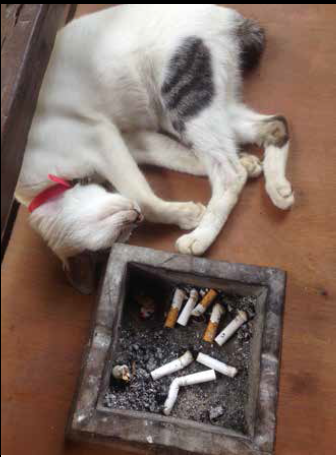 The three of us drove with Leo to the foot of the volcano and then hired three loud motorbikes driven by three spirited Javanese kids – 15, 14 and 16 years old Fatima, Abu and Murtaza. Sitting behind them, scaling Mount Merapi was an experience that became special because of their stories. We stopped in between to soak it all and saw some sites that had to be seen. The three of them showed us their homes that were frightfully close to the volcano and spoke about the recent eruptions with impressive matter of fact-ness. Without a single suggestion of being overwhelmed, for them, it was just a mountain that spewed lava once every 3-4 years and destroyed parts of or the whole village. Once it was done with, the villagers went about putting their houses together and getting on with their lives. That was that.
The three of us drove with Leo to the foot of the volcano and then hired three loud motorbikes driven by three spirited Javanese kids – 15, 14 and 16 years old Fatima, Abu and Murtaza. Sitting behind them, scaling Mount Merapi was an experience that became special because of their stories. We stopped in between to soak it all and saw some sites that had to be seen. The three of them showed us their homes that were frightfully close to the volcano and spoke about the recent eruptions with impressive matter of fact-ness. Without a single suggestion of being overwhelmed, for them, it was just a mountain that spewed lava once every 3-4 years and destroyed parts of or the whole village. Once it was done with, the villagers went about putting their houses together and getting on with their lives. That was that.
Being one of the oldest cities in Indonesia, Jogja also has many heritage buildings and monuments. Borobudur is one of world’s truly great ancient monuments, the single largest Buddhist structure anywhere on earth, and few who visit fail to be taken by both the scale of place, and the remarkable attention to detail that went into the construction.
History tells that Borobudur lay abandoned and hidden for centuries under layers of volcanic ash and thick jungle growth. Nobody knows for sure why it was abandoned, although the popular theories are that the local population just became uninterested when there were mass conversions to Islam in the 15th century, or they were simply driven away by large volcanic eruptions. It was never forgotten entirely though, with local folklore ensuring that stories of the great monument lived on.
Today it is a major tourist attraction. Alessandro and I climbed to the top and admired the views. A curious observation was seeing the chopped off heads of Buddha as a result of Islamisation of the country, especially Java. It was initially believed that Islam penetrated Indonesian society in a largely peaceful manner and was brought in by traders from Gujarat, India in the eleventh century. So to imagine these peaceful Muslim raiders chopping off the heads, as they had to be chopped and keeping intact the glory of the monument does demonstrate a level of religious tolerance. A fair amount of the temple is restored but I was glad that they did not try to place the heads back as it reminds you of two distinct periods in history.
Another place that should be visited is the Sultan’s palace. If one has seen the forts and palaces in India, this one is a fairly ordinary one. But what it lacks in majesty, it makes up for what it stands for. The Sultan, a Muslim, observed both Ramadan (Islam’s religious observance) and Dusshera (a major Hindu festival) with equal fervour. Being a Hindu myself and coming from a country that is steeped in religious diversities, it was extremely interesting to observe a sort of a mish-mash of Hindu, Islamic and Buddhist traditions in the palace museum. There were no clear demarcations and all religions were merged into one quite easily.
I arrived by train from Jakarta and the ticket cost me USD 9. To get to it from India, check out cheap air connections from Air Asia. Try to be flexible with time and catch cheap deals on the airline. Before buying your ticket, always consult Skyscanner or Kayak once. It tracks all the best deals.
“It was the gentle purring of two cats – one curled next to my cheek and the other at my feet that finally awoke me after who knows how many hours”.
Accommodation
I stayed at Omah Jogek. To book from Air BnB, it just costs USD 20, which if you ask me is a very small price for what you get. Though I have not done it myself, it is worth a try to connect with them through their Facebook page for a booking enquiry. But if you’re not a cat/dog person, another good option is ViaViaJogja. A bit more expensive but a good option if you’re excitedly looking for things to do and places to go. Hostels usually cost around USD 12 per night for a shared room and USD 24 for a double private. Prices will be up to half the price outside of the major cities. Most hotels begin at USD 27 per night for a double room.
Food
Food is cheap. You can save a lot by sticking to street food. You can pick up tasty local fare for around USD 50 cents! Street side snacks, soups, and noodles will keep your wallet fat! Markets are your best bet for finding seriously cheap food. Western food is more expensive but is still affordable at around USD 9 for a meal and drink.
Visa
Indonesian visa is available on arrival for Indian passport holders and cheaper than getting a visa from India. It costs: US$50. There are hardly any queues so I don’t know why would anyone go through the trouble of getting the visa stamped from before.
